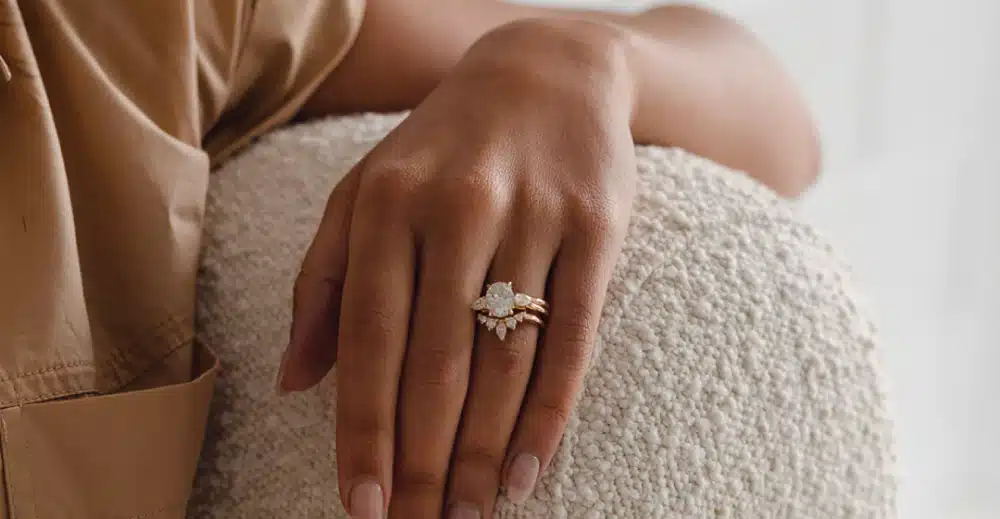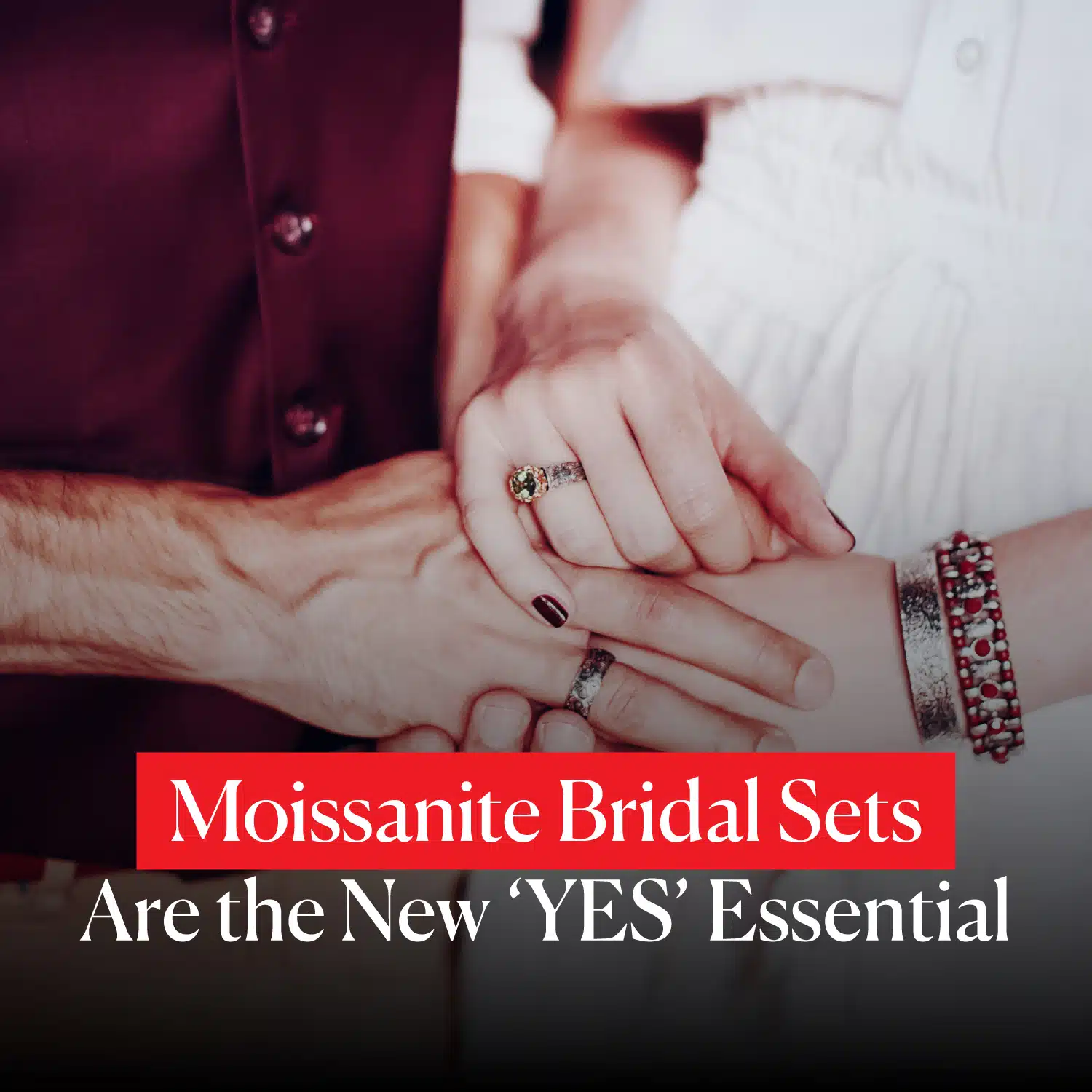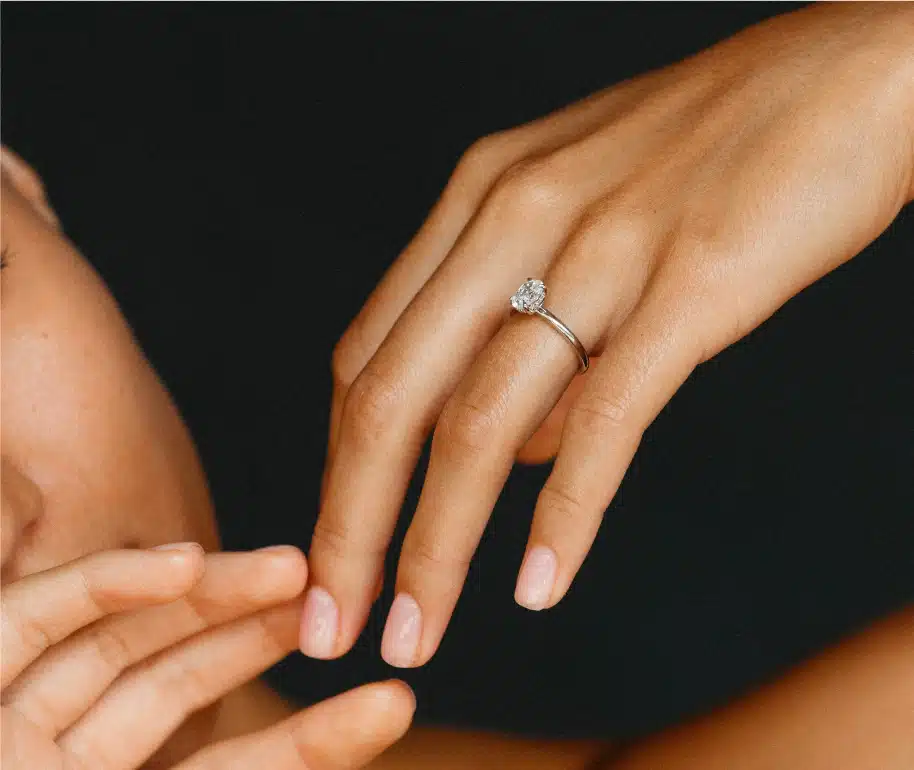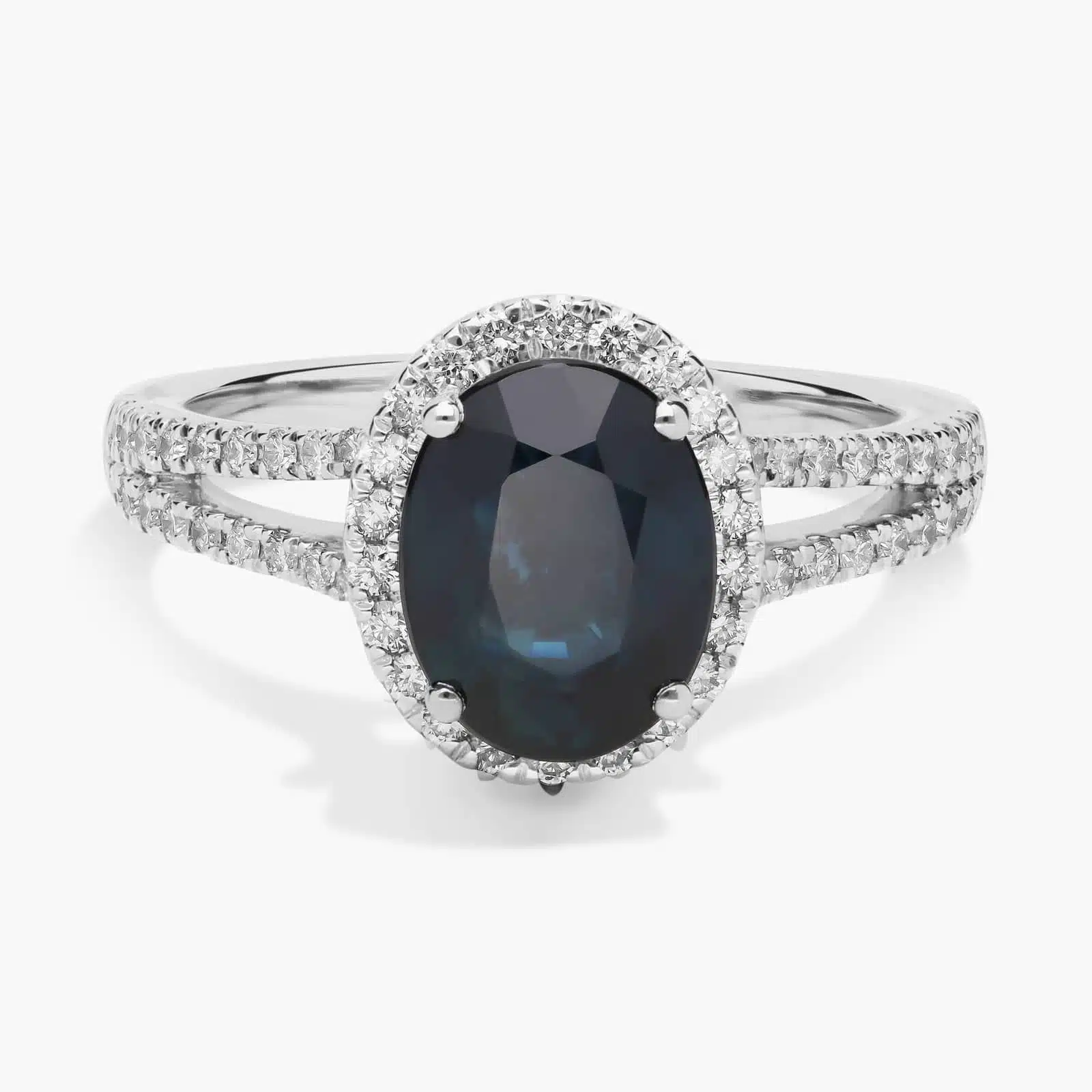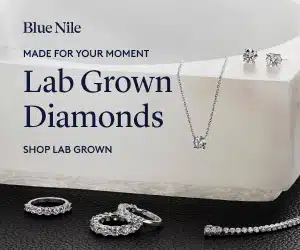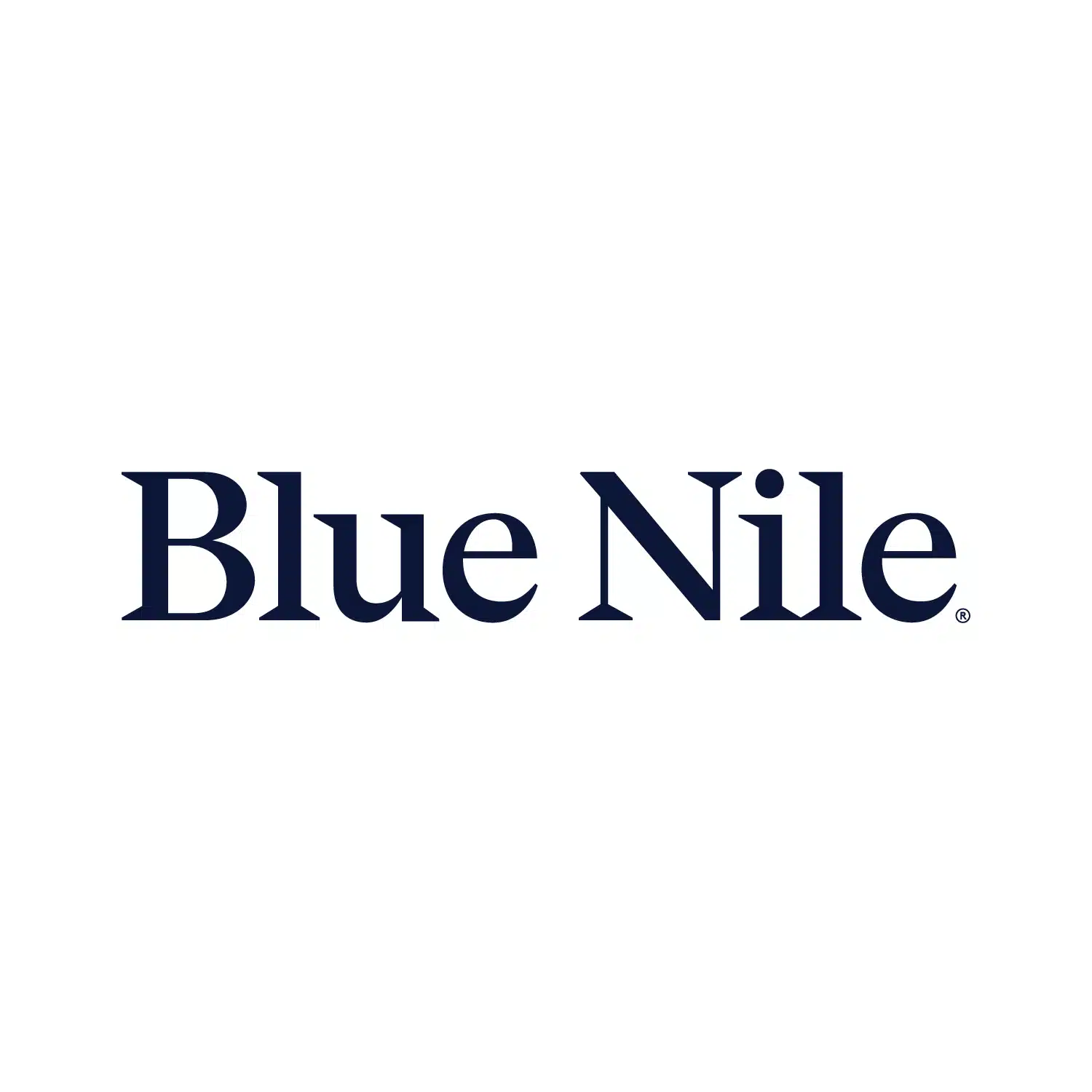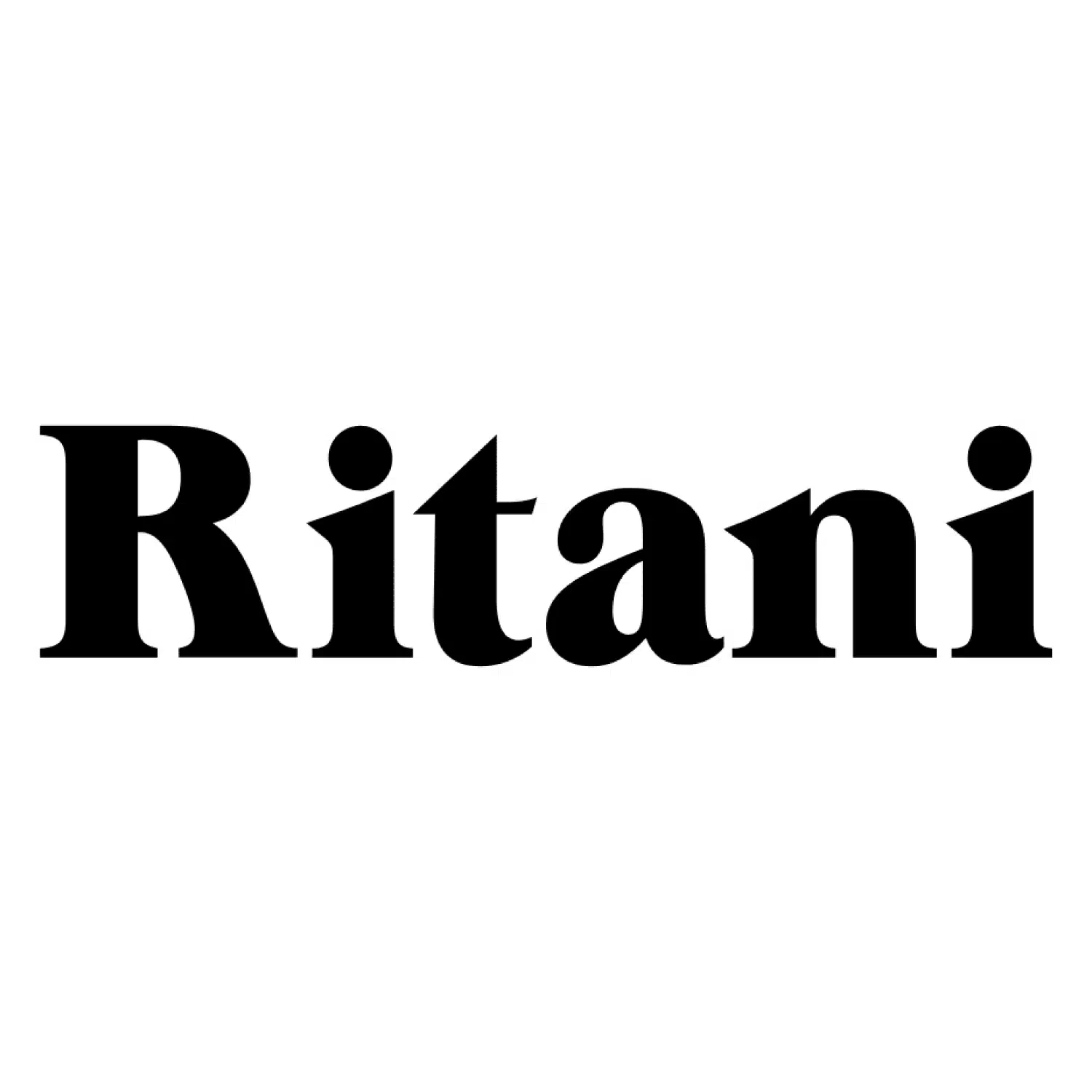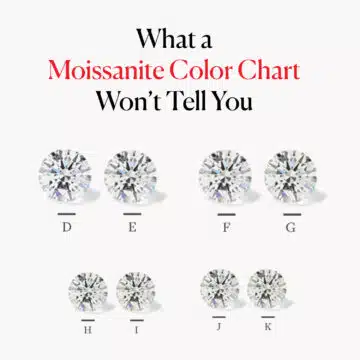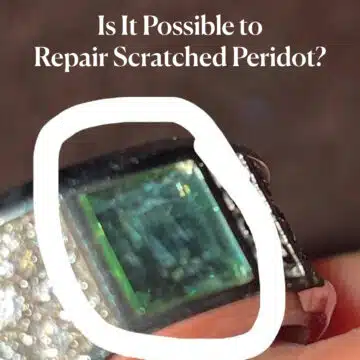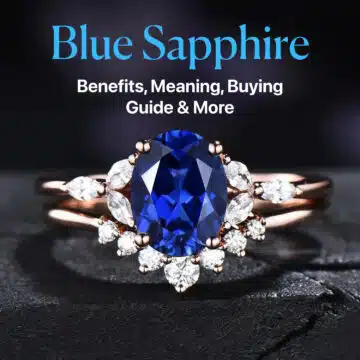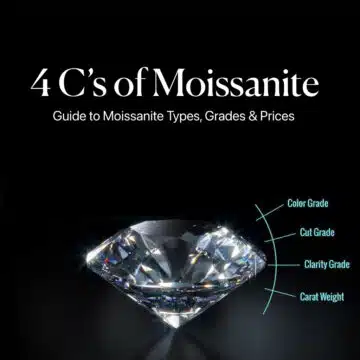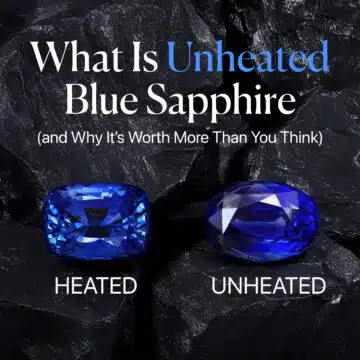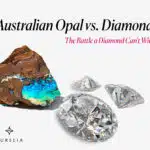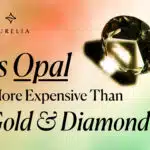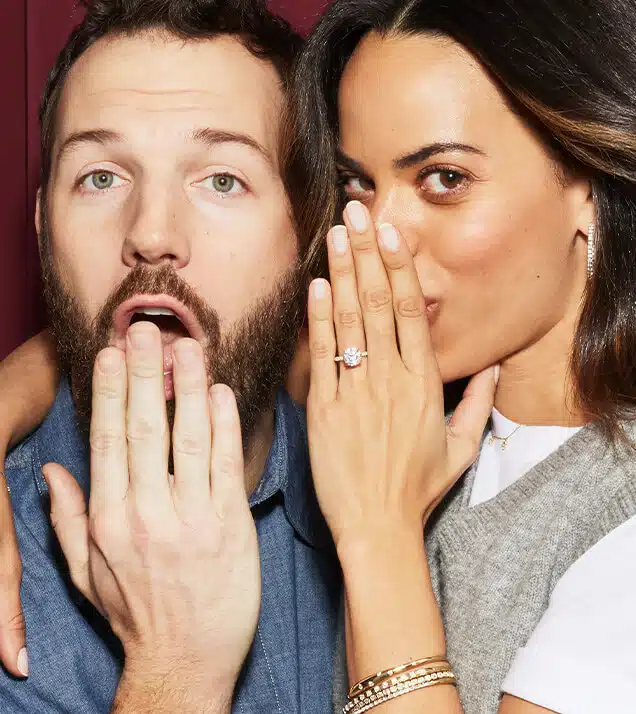When shopping for diamonds, understanding the color can be tricky, but here’s the good news: you can get a stunning, colorless diamond without paying for the highest grade. E color diamonds sit just below D color diamonds in the GIA grading system, making them part of the colorless range, but at a more affordable price.
The GIA diamond grading scale measures a diamond’s color on a scale from D to Z, with D being the most colorless and E just slightly warmer, though the difference is nearly impossible to see with the naked eye.
When considering diamonds, you also need to think about the Diamond 4Cs: cut, clarity, carat weight, and color. E color grade diamonds are an excellent choice for those who want the beauty of a high-quality diamond without the premium price tag of D color diamonds.
In this post, you’ll discover how E color diamonds compare to D, F, and G color diamonds, and where you can buy these stunning stones from trusted retailers like James Allen, Blue Nile, and more.
- What is an E Color Diamond?
- E Color vs. D Color: Is Paying More Worth It?
- E Color vs. F Color: Almost Identical, But Much Cheaper
- E Color vs. G Color: The Best Balance of Value & Beauty
- E Color vs. H Color: Significant Savings for Similar Visual Appeal
- E Color vs. I Color: Savings That Add Up
- Best Places to Buy an E Color Diamond
- Final Thoughts: Should You Buy an E Color Diamond?
- Frequently Asked Questions (FAQs)
What is an E Color Diamond?

Diamonds are graded on a color scale that ranges from D (colorless) to Z (light yellow or brown). The GIA Diamond Color Scale is one of the most respected systems, and E color diamonds are just one grade below D, falling into the “colorless” category.
This makes them an excellent choice for anyone seeking a top-tier, high-quality diamond without the premium price tag of a D color diamond.
Here’s a quick summary of what makes E color diamonds special:
- E Color Diamonds are colorless to the naked eye, offering exceptional beauty.
- They look almost identical to D color diamonds, but come at a more affordable price point.
- E color diamonds are ideal for engagement rings, fine jewelry, or any special occasion where you want a high-quality piece without paying top dollar.
If you’re curious about how these diamonds compare to others, check out our diamond grading chart to learn more about how diamonds are rated across all the grades.
The E Color Advantage
One of the best reasons to consider E color diamonds is the value for money they offer. They provide the highest colorless quality but come at a lower price than D color diamonds. Here are some key benefits of choosing E color diamonds:
- Nearly identical to D diamonds: Both look the same in everyday lighting, making it tough to differentiate between them.
- More affordable: You’ll save money without sacrificing beauty, as E color diamonds typically cost 20-30% less than D color diamonds.
- Ideal for budget-conscious buyers: If you’re after the “colorless” diamond look, but want to keep the price down, E color diamonds are a perfect choice.
If you’d like to explore the relationship between cut and color to determine the overall diamond quality, be sure to check out our diamond cut chart for more insights.
For instance, a 1-carat E color diamond can start from around $6,500 at trusted retailers like James Allen and Blue Nile. But, diamonds with slightly lower color grades, such as G or H, still appear beautiful and can be priced lower, starting at approximately $5,000.
It’s important to choose a diamond that fits both your budget and your preferences. Don’t forget that cut and carat size also significantly impact the price and overall look of your diamond.
Learn more about diamond carat weight and its effect on price with our diamond carat size chart.
Diamond IQ Test: Natural or Lab-Grown?
Two identical diamonds: GIA Certified, 1.51ct, D Color, VVS1, Ideal Cut. One is natural ($16,530), the other is lab-grown ($2,390). Choose the diamond you like better and see if you can match it to its origin.
E Color vs. D Color: Is Paying More Worth It?
When deciding between a D color diamond and an E color diamond, the key question is whether the higher price of a D color is justified by any visible difference.
Both are graded as colorless on the GIA scale, meaning they lack noticeable yellow or brown tint. But is the premium for a D color stone really necessary?
How Different Are D and E Color Diamonds?
The distinction between D and E color diamonds is nearly imperceptible to the naked eye. D color diamonds are completely devoid of color, while E color diamonds may have an extremely faint trace of warmth that is only detectable under high magnification.
For the average buyer, both diamonds appear identical once set in a ring.
Since diamond shape plays a major role in how color is perceived, certain shapes, such as emerald or Asscher cuts, might reveal more color than round or oval diamonds.
Understanding how diamond shapes influence appearance can help in choosing the right balance between color grade and overall brilliance.
D vs. E Color Diamond Pricing
Diamond prices fluctuate based on factors like carat weight, cut quality, and clarity, but in general, D color diamonds range from $1,703 to $8,920, while E color diamonds cost between $2,112 and $5,029.
To illustrate the difference, here’s a comparison of natural and lab-grown D vs. E color diamonds across various carat weights:
D vs. E Color Diamond Price Comparison (Natural & Lab-Grown Diamonds)
| Carat Weight | D Color (Natural) | E Color (Natural) | D Color (Lab-Grown) | E Color (Lab-Grown) |
|---|---|---|---|---|
| 1.0 Carat | $6,500 – $8,900 | $5,800 – $7,500 | $1,000 – $1,500 | $800 – $1,200 |
| 2.0 Carat | $18,000 – $25,000 | $15,000 – $22,000 | $2,500 – $4,500 | $2,000 – $4,000 |
| 3.0 Carat | $40,000 – $55,000 | $35,000 – $48,000 | $5,000 – $7,500 | $4,000 – $6,500 |
| 4.0 Carat | $80,000 – $110,000 | $70,000 – $100,000 | $8,000 – $12,000 | $7,000 – $11,000 |
| 5.0 Carat | $150,000+ | $130,000+ | $12,000 – $18,000 | $10,000 – $16,000 |
Why Does the D Color Diamond Cost More Than the E Color Diamond?
Let’s break this down using two real diamonds from James Allen:

- D Color, 1.00 Carat, VVS1 Clarity – $6,500
- E Color, 1.00 Carat, VVS1 Clarity – $5,670
At first glance, they look almost identical. Same carat weight, same clarity, both round cuts. So why is the D color diamond $830 more expensive?
Does the Color Difference Matter?
If you’re like me, you might be wondering—can you actually see the difference between a D and an E color diamond? The short answer? Not really. Both are in the colorless range on the GIA scale, meaning neither will show any noticeable tint when worn.
So why the price gap? Rarity.
A D color diamond is the highest grade possible, meaning it has absolutely no detectable color, even under a jeweler’s loupe. E color diamonds are also colorless, but under magnification, a trained gemologist might detect the slightest hint of color.
The truth is, you won’t see a difference in everyday lighting, but diamond pricing is driven by precision grading and rarity.
Other Factors That Impact Price
Beyond color, there are a couple of other things happening here:
- Fluorescence: The D color diamond has medium fluorescence, while the E color diamond has faint fluorescence. Some buyers worry that fluorescence can make a diamond look hazy, which sometimes leads to a small price discount—especially for high-color diamonds like D.
- Cut Proportions: The E color diamond has a slightly shallower depth (63.7%) and a larger table (59%), which can make it look a tiny bit bigger face-up. The D color diamond is a bit deeper (64.6%) with a smaller table (58%), meaning it may return light differently.
Lifetime Protection Alert!
A James Allen purchase includes a free lifetime warranty. This covers free prong tightening, polishing, and cleaning for life, ensuring your jewelry always looks its best.
Should You Pay More for a D Color Diamond?
This comes down to what matters most to you.
If you want to say, “I have the absolute best color grade,” then go for the D color diamond. It’s the rarest and holds value well over time.
But if you’re looking for the best balance of price and beauty, the E color diamond is a smarter choice. You’re saving over $800 while still getting a diamond that looks just as colorless to the naked eye.
So ask yourself: Do you want the best rarity or the best value? Either way, you’re getting a stunning diamond.
Is Paying More for a D Color Diamond Worth It?
For most buyers, an E color diamond offers a better value without compromising on appearance. Since cut quality has a greater impact on brilliance than color, a well-cut E color stone will often look just as bright as a D color diamond.
If you’re exploring ways to maximize sparkle, it’s important to consider how diamond cut quality affects light performance.
Additionally, the rise of lab-grown diamonds has made colorless diamonds more accessible at lower price points. Lab-created stones follow the same GIA certification process as natural diamonds, offering identical quality without the steep price tag.
You can learn more about GIA-certified synthetic diamonds and their benefits in our comprehensive guide.
When choosing a diamond, factors like shape, cut, and whether it’s lab-grown or natural all influence its final appearance and value. If you’re still deciding between a D or E color diamond, understanding how GIA-certified synthetic diamonds compare to natural stones can provide additional insight.
E Color vs. F Color: Almost Identical, But Much Cheaper
When comparing E color diamonds to F color diamonds, you’ll find that they are nearly identical in terms of visual appearance. The key difference is often found in their price tag, which makes F color diamonds a fantastic option for those seeking a colorless diamond without breaking the bank.
What Makes F Color Special
F color diamonds are positioned just one step below E color diamonds on the GIA scale. Like E color diamonds, they are technically colorless, but F color diamonds may have the faintest hint of warmth that’s almost impossible to detect with the naked eye. In fact, unless you’re a trained gemologist or using specialized tools, the difference is barely noticeable.
The GIA grading scale places both E and F color diamonds in the same “colorless” category, meaning they are free from any discernible yellow or brown hues.
However, F color diamonds tend to be slightly more affordable, making them an attractive choice for those looking for a high-quality diamond without paying a premium for the most perfect stone.
Price Advantage
The price difference between E color and F color diamonds is typically modest, but over time, those savings can add up. For instance, a 1-carat F color diamond from James Allen can be priced at approximately $6,200, which is about $300 cheaper than its E color counterpart, which typically costs around $6,500.
Given how E and F color diamonds are almost indistinguishable to the naked eye, this small price difference offers a compelling value for those looking to save money while still obtaining a colorless diamond. You can enjoy a diamond of nearly identical beauty, yet at a more budget-friendly cost.
Visual Test
Even under close scrutiny, you won’t notice a major difference between E color and F color diamonds when they are set in a ring. The diamond’s cut and overall brilliance often play a much bigger role in how the stone appears to the eye.
When set in white gold or platinum, both E and F color diamonds will sparkle with a clean, colorless glow, making it difficult to distinguish one from the other.
Because the difference is so subtle, many people may opt for F color diamonds to get a top-quality, colorless diamond for a more affordable price, without sacrificing the appearance of a high-end stone.
A real-world example of this is a 1-carat round cut F color diamond offered by James Allen for $6,200. When compared to E color diamonds, which can be priced at $6,500, this F color diamond represents a great value for those on a budget, yet who still want the elegance and beauty of a colorless diamond.
It’s a great choice for those who want to maximize their budget while still getting a stone that appears almost identical to a higher-grade diamond.
Both E color diamonds and F color diamonds offer exceptional beauty, and the slight price difference between them makes F color diamonds a more affordable alternative for those who want a top-quality stone at a better value.
E Color vs. G Color: The Best Balance of Value & Beauty
When shopping for a diamond, finding the right balance between value and beauty is crucial. E color diamonds and G color diamonds provide just that. E color diamonds fall in the colorless category of the GIA diamond grading scale, and while G color diamonds are a step lower, they still have exceptional quality and appear colorless in many settings.
Why G Color Is Still Great
While G color diamonds are technically not as high in grade as E color diamonds, they still fall within the “near-colorless” range. G color diamonds might show a very slight hint of warmth when compared to E color diamonds, but in most cases, this is practically invisible to the naked eye, especially when set in white gold or platinum.
The difference between E and G color diamonds is subtle, and the savings that come with choosing a G color diamond can make a big difference in terms of budget, especially when you’re shopping for larger carat diamonds.
Many buyers find that they can get a bigger or higher-quality diamond for a similar price, thanks to the more affordable price of G color diamonds.
Price Comparison
The price difference between E color and G color diamonds can be significant. For example, a 1-carat G color diamond from Blue Nile is priced at $5,950, which is around 10% cheaper than the E color diamond priced at $6,500. Over time, this price difference can add up, especially when considering larger carat sizes.
Best Deal Of The Year – Final Days
Blue Nile’s “Clear The Vault” is ON.
Shop Fine Jewelry Upto 70% OFF.
*Exclusions may apply. See Blue Nile for complete details.
Despite the slight difference in color, G color diamonds are still an excellent value for anyone looking for a stunning diamond with an attractive price tag. When set in a high-quality setting, the G color diamond will often look very similar to a higher-grade E color diamond, with a notable price benefit.
The price difference is significant for anyone on a budget, and the difference in appearance between G and E color diamonds is so small that many buyers feel comfortable saving that money.
Comparison Table: E Color vs. G Color Diamond Prices
| Carat Weight | E Color Diamond Price (Approx.) | G Color Diamond Price (Approx.) | Price Difference |
|---|---|---|---|
| 1 Carat | $6,500 | $5,950 | -$550 |
| 1.5 Carat | $9,500 | $8,700 | -$800 |
| 2 Carat | $12,500 | $11,300 | -$1,200 |
| 3 Carat | $18,000 | $16,000 | -$2,000 |
| 4 Carat | $24,000 | $21,500 | -$2,500 |
This table shows the price difference between E color and G color diamonds at various carat weights. As you can see, the larger the diamond, the more you can save by choosing G color over E color.
E Color vs. H Color: Significant Savings for Similar Visual Appeal
When choosing the perfect diamond, one of the key factors is finding the right balance between price and appearance. E color diamonds are a popular choice for those seeking colorless stones, but H color diamonds also offer a similar visual appeal, with some significant savings.
A Clear Difference in Price, Not Appearance
H color diamonds fall into the “near-colorless” range on the GIA scale, which is just a few steps below E color diamonds. The main difference between E and H color diamonds is that H color diamonds have a slightly warmer hue, but this difference is often imperceptible to the naked eye.
In fact, many customers find it hard to notice any visible difference when the diamond is set in a ring or jewelry piece, especially when placed in white gold or platinum settings.
For those on a budget, H color diamonds offer an excellent opportunity to save a considerable amount without sacrificing much in terms of aesthetic appeal.
The slight tint present in H diamonds is barely noticeable in everyday wear, so it is often an excellent choice for buyers seeking an affordable diamond with a colorless look.
Price Comparison
Price is where the main difference between E color and H color diamonds lies. A 1-carat H color diamond from James Allen is priced at approximately $5,000, which is a $1,500 savings compared to the $6,500 price of an E color diamond.
This price difference is significant, making H color diamonds a fantastic option for those looking to get the most value for their money.
Pro Tip: If you’re looking for a diamond within a budget but still want to maintain a colorless appearance, H color diamonds are an excellent choice. When set in a high-quality setting, the slight color difference between E and H color diamonds is nearly impossible to detect without magnification.
Choosing H color can be a smart way to invest in a high-quality, affordable diamond while still achieving the beautiful, timeless look of a colorless diamond.
E Color vs. I Color: Savings That Add Up
When choosing a diamond, balancing color, price, and appearance is crucial. E color diamonds are prized for their colorless beauty, but I color diamonds offer a smart alternative for budget-conscious buyers. The savings are significant, and in many cases, the difference in appearance is minimal.
Why Choose an I Color Diamond?
I color diamonds fall into the “near-colorless” range on the GIA color scale. While they may have a slight warm tint, especially in larger sizes, they still appear bright and beautiful in most settings. The tint is less noticeable when set in yellow gold or rose gold, as these metals naturally complement the diamond’s warmth.
Even in white gold or platinum, the difference can be hard to detect unless compared side by side with a higher color grade.
For buyers looking for the best budget diamond, I color diamonds provide exceptional value without a drastic compromise in visual appeal.
Price Advantage
The biggest reason to consider an I color diamond is the cost savings. A 1-carat I color diamond from Blue Nile or James Allen is priced around $4,200, compared to approximately $6,500 for an E color diamond of the same size and clarity.
That’s a $2,300 difference—a major saving that can be used to upgrade carat weight, clarity, or even go toward a higher-quality setting.
What to Expect
While the price gap between E color and I color diamonds is substantial, the visual difference is often far less noticeable than expected. In most lighting conditions, an I color diamond can look almost identical to an E or G color diamond, especially in halo or pavé settings, which add extra brilliance and help mask any slight tint.
To illustrate the value of an I color diamond, Blue Nile offers a 1-carat I color diamond for $4,200. This demonstrates just how much you can save by opting for a lower color grade, while still owning a stunning, high-quality diamond.
Best Places to Buy an E Color Diamond

When buying an E color diamond, it’s crucial to choose a reputable retailer that offers the right balance of pricing, selection, and customer service. Some retailers stand out for their detailed imaging, while others excel in in-store previews or sustainability.
Below is a breakdown of the top places to buy an E color diamond, along with their advantages and drawbacks.
1. James Allen
Best for: Buyers who want 360° HD images and competitive pricing
James Allen has revolutionized the way people buy diamonds online by offering ultra-high-resolution 360° images of every diamond in their inventory. This feature alone makes it one of the best places to buy an E color diamond, allowing customers to inspect the stone for inclusions, brilliance, and overall quality before purchasing.
Lifetime Protection Alert!
A James Allen purchase includes a free lifetime warranty. This covers free prong tightening, polishing, and cleaning for life, ensuring your jewelry always looks its best.
A customer I spoke with, Alex, shared his experience buying an E color diamond from James Allen:
“I was skeptical about buying a diamond online, but the 360° images really helped. I could compare three different E color diamonds side by side and pick the one that looked perfect. When it arrived, the packaging was elegant, and the diamond exceeded my expectations.”
James Allen: Our 5-Star Choice for Price and Selection
Check our comprehensive James Allen Review to learn more about their pricing and commitment.
James Allen offers a vast selection of GIA-certified diamonds starting at $6,500. They also provide a free lifetime warranty, covering maintenance like prong tightening and polishing, adding extra long-term value.
However, since they don’t have physical stores, customers need to rely entirely on online images and customer service.
- Pros: 360° imaging, competitive pricing, free lifetime warranty, great customer service
- Cons: Some settings take longer to ship
James Allen is a top leader in online diamond sales, offering cutting-edge imaging technology that lets you inspect diamonds as if you were using a jeweler's loupe. With the largest exclusive selection of loose diamonds available online and excellent pricing, they also boast one of the finest collections of lab-created diamonds on the market. They currently run a 25% discount on selected lab-grown diamonds!
WHAT WE LOVE ABOUT THEM:
- 30-day no-questions-asked return policy, with a prepaid shipping label provided by James Allen.
- Lifetime warranty on all purchases.
- Free international shipping.
- Complimentary prong tightening, repolishing, rhodium plating, and cleaning every six months.
- Insurance appraisals included with purchases.
- One free resizing within 60 days of purchase.
- Free ring inscriptions available.
- Best-in-class high-quality imagery for every diamond in stock.
- 24/7 customer support.
- Premium, best-in-class packaging.
2. Blue Nile
Best for: Trusted reputation and frequent promotions
Blue Nile has been a dominant force in the diamond industry for over two decades, offering one of the largest diamond inventories available online. Their E color diamonds start at around $6,300, and they frequently offer seasonal promotions that help buyers save hundreds of dollars.
Best Deal Of The Year – Final Days
Blue Nile’s “Clear The Vault” is ON.
Shop Fine Jewelry Upto 70% OFF.
*Exclusions may apply. See Blue Nile for complete details.
One customer I spoke with, Sarah from Texas, mentioned that she chose Blue Nile because of its strong reputation:
“I wanted an E color diamond but didn’t want to overpay. Blue Nile had a much bigger selection than local jewelers, and I even managed to get a discount during one of their promotions. The only downside was that not all diamonds had 360° videos, so I had to rely more on the certification.”
Read Our 5-Star Blue Nile Review
Check our comprehensive Blue Nile review to learn why we rated Blue Nile 5 stars for their exceptional quality and value.
Unlike James Allen, not all diamonds come with HD images, but their price-matching policy and frequent discounts make them a great option for budget-conscious shoppers. They also provide a 30-day return policy and insured shipping, making the process low-risk.
- Pros: Large selection, frequent promotions, competitive pricing, strong reputation
- Cons: Not all diamonds have 360° imaging.
Blue Nile is one of the biggest and most recognized online jewelry retailers, offering an extensive and exclusive inventory. Their high-resolution images are improving and getting closer to the quality offered by James Allen, while their prices remain highly competitive. Right now, Blue Nile offers up to 30% savings on jewelry during a limited-time sale.
WHAT WE LOVE ABOUT THEM:
- 30-day no-questions-asked return policy, with a prepaid shipping label provided by Blue Nile.
- Lifetime warranty on all purchases.
- Free shipping on every order.
- Complimentary services every six months, including prong tightening, repolishing, rhodium plating, and cleaning.
- Insurance appraisal included with your purchase.
- One free resizing within the first year.
- High-quality images available for roughly half of their diamond selection.
- 24/7 customer service support.
- Full credit toward future upgrades, as long as the new item is at least double the value.
- Best-in-class order fulfillment process.
3. Ritani
Best for: In-store previews and custom designs
For buyers who want to see a diamond in person before purchasing, Ritani is an excellent option. Unlike most online retailers, Ritani allows customers to ship a diamond to a local jeweler for an in-store preview before committing to the purchase. This is perfect for those hesitant about buying a high-value item online.
One of the standout features of Ritani is their hybrid model, which blends the convenience of online shopping with the reassurance of physical inspection.
They also specialize in custom engagement rings, giving buyers more flexibility in designing their dream ring.
However, Ritani’s pricing is slightly higher than James Allen or Blue Nile, especially for premium-cut diamonds. But for those who value the ability to see their E color diamond before buying, the extra cost might be worth it.
- Pros: In-store previews, custom ring designs, strong customer service
- Cons: Higher prices than competitors, smaller selection
Ritani is a trusted name in the online jewelry industry, known for its stunning collection of ethically sourced diamonds and gemstones. With a focus on transparency, Ritani offers customers in-depth diamond education and innovative features like in-store preview options, ensuring a seamless and informed shopping experience.
WHAT WE LOVE ABOUT THEM:
- Free in-store preview of loose diamonds before purchase.
- 30-day free returns, including resizing services for all rings.
- Lifetime warranty that covers prong tightening, polishing, rhodium plating, and more.
- Free insured shipping on all orders.
- Access to a wide selection of GIA-certified diamonds and lab-grown options.
- High-resolution 360° videos of diamonds for accurate evaluation.
- Ethical sourcing and conflict-free diamonds.
- Buy Now, Pay Later financing options available.
- 24/7 customer service with personalized consultations.
4. Vrai
Best for: Ethical and sustainable diamonds
If sustainability is a top priority, Vrai is one of the best places to buy a diamond. They specialize in lab-grown diamonds, offering E color lab-created diamonds at a lower cost than mined ones. Vrai’s diamonds are carbon-neutral, making them a great choice for environmentally conscious buyers.
One customer, Daniel from New York, told me he chose Vrai because of their sustainability focus:
“I really wanted an E color diamond but didn’t want to go with a mined stone. Vrai’s diamonds are lab-grown and look just as stunning. The price was also much lower than a natural E color diamond, so it was a win-win for me.”
While Vrai’s selection of natural diamonds is limited, their lab-grown E color diamonds offer excellent quality at a fraction of the cost. However, buyers looking for a large inventory of mined diamonds might prefer James Allen or Blue Nile.
- Pros: Ethical and sustainable, lower prices for lab-grown diamonds, great customer service
- Cons: Limited selection of mined diamonds.
Final Thoughts: Should You Buy an E Color Diamond?
E color diamonds offer a near-perfect balance between exceptional whiteness and reasonable pricing compared to D color diamonds. If you prioritize a diamond that appears icy white without paying the premium for a D color, an E color diamond is an excellent choice.
However, if you’re on a budget, you might want to explore G, H, or even I color diamonds, as they can look nearly identical in the right setting while costing significantly less. The difference between an E and G color diamond is often subtle, especially in round brilliant cuts or when set in white gold or platinum.
Who Should Buy an E Color Diamond?
- Buyers who want a near-flawless white diamond without paying for a D color
- Those who prefer higher color grades for investment or resale value
- Anyone looking for a diamond that stands out in platinum or white gold settings
However, if you’re looking for the best value for money and are okay with minor warmth in color, you might find a G or H color diamond to be the smarter buy.
Recommendation
If you’re ready to purchase an E color diamond, the best places to start are James Allen and Blue Nile. Both retailers offer a vast selection of GIA-certified diamonds, 360° HD images, and competitive pricing.
- James Allen: Best for detailed diamond imaging and side-by-side comparisons
- Blue Nile: Best for large inventory and frequent promotions
Use their search filters to narrow down your options based on carat weight, clarity, budget, and fluorescence to find the best diamond for your needs.

